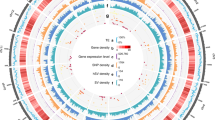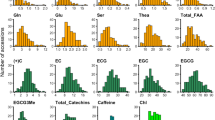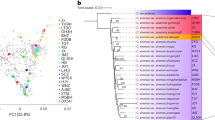Abstract
Main conclusion
Functional allelic variants of the flavonoid 3′,5′-hydroxylase (F3′5′H) gene provides new information of F3′5′H function of tea plant and its relatives. This insight may serve as the foundation upon which to advance molecular breeding in the tea plant.
Catechins are the active components of tea that determine its quality and health attributes. This study established the first integrated genomic strategy for deciphering the genetic basis of catechin traits of tea plant. With the RNA-sequencing analysis of bulked segregants representing the tails of a F1 population segregated for total catechin content, we identified a flavonoid 3′,5′-hydroxylase (F3′5′H) gene. F3′5′H had one copy in the genomic DNA of tea plant. Among 202 tea accessions, we identified 120 single nucleotide polymorphisms (SNPs) at F3′5′H locus. Seventeen significant marker-trait associations were identified by association mapping in multiple environments, which were involved in 10 SNP markers, and the traits including the ratio of di/tri-hydroxylated catechins and catechin contents. The associated individual and combination of SNPs explained 4.5–25.2 and 53.0–63.0% phenotypic variations, respectively. In the F1 population (validation population), the catechin trait variation percentages explained by F3′5′H diplotype were 6.9–74.3%. The genotype effects of ten functional SNPs in the F1 population were all consistent with the association population. Furthermore, the function of SNP−711/−655 within F3′5′H was validated by gene expression analysis. Altogether, our work indicated functional SNP allelic variants within F3′5′H governing the ratio of di/tri-hydroxylated catechins and catechin contents. The strong catechin-associated SNPs identified in this study can be used for future marker-assisted selection to improve tea quality.







Similar content being viewed by others
Abbreviations
- BFR:
-
Bulk frequency ratio
- BSR-Seq:
-
Bulked segregant RNA-seq
- CI:
-
Catechin index
- DIC:
-
Dihydroxylated catechins
- DRR:
-
Downstream regulatory region
- EC:
-
(–)-Epicatechin
- ECG:
-
(–)-Epicatechin gallate
- EGC:
-
(–)-Epigallocatechin
- EGCG:
-
(–)-Epigallocatechin gallate
- F3′H:
-
Flavonoid 3′-hydroxylase
- F3′5′H:
-
Flavonoid 3′,5′-hydroxylase
- FDR:
-
False discovery rate
- FPKM:
-
Fragment per kilobase of exon model per million mapped reads
- gDNA:
-
Genomic DNA
- LD:
-
Linkage disequilibrium
- MLM:
-
Mixed linear model
- NGS:
-
Next generation sequencing
- QTL:
-
Quantitative trait loci
- r 2 :
-
The squared correlation of allele frequencies
- RNA-seq:
-
RNA-sequencing
- SNP:
-
Single nucleotide polymorphism
- TC:
-
Total catechins
- TRIC:
-
Trihydroxylated catechins
- URR:
-
Upstream regulatory region
References
Bradbury PJ, Zhang Z, Kroon DE, Casstevens TM, Ramdoss Y, Buckler ES (2007) TASSEL: software for association mapping of complex traits in diverse samples. Bioinformatics 23:2633–2635
Chen L, Zhou ZX (2005) Variations of main quality components of tea genetic resources [Camellia sinensis (L.) O. Kuntze] preserved in the China national germplasm tea repository. Plant Foods Hum Nutr 60:31–35
Chung FL, Schwartz J, Herzog CR, Yang YM (2003) Tea and cancer prevention: studies in animals and humans. J Nutr 133:3268–3274
Cole T, Brian AW, Geo P, Ali M, Gordon K, Marijke JB, Steven LS, Barbara JW, Lior P (2010) Transcript assembly and abundance estimation from RNA-Seq reveals thousands of new transcripts and switching among isoforms. Nat Biotechnol 28:511–515
Dellaporta SL, Wood J, Hicks JB (1983) A plant DNA mini preparation: version II. Plant Mol Biol Rep 1:19–21
Du Q, Tian J, Yang X, Pan W, Xu B, Li B, Ingvarsson PK, Zhang D (2015) Identification of additive, dominant, and epistatic variation conferred by key genes in cellulose biosynthesis pathway in Populus tomentosa. DNA Res 22:53–67
Du Q, Gong C, Wang Q, Zhou D, Yang H, Pan W, Li B, Zhang D (2016) Genetic architecture of growth traits in Populus revealed by integrated quantitative trait locus (QTL) analysis and association studies. New Phytol 209:1067–1082
Feder A, Burger J, Gao S, Lewinsohn E, Katzir N, Schaffer AA, Meir A, Davidovich-Rikanati R, Portnoy V, Gal-On A, Fei Z, Kashi Y, Tadmor Y (2015) A kelch domain-containing F-box coding gene negatively regulates flavonoid accumulation in muskmelon. Plant Physiol 169:1714–1726
Flint-Garcia SA, Thuillet AC, Yu J, Pressoir G, Romero SM, Mitchell SE, Doebley J, Kresovich S, Goodman MM, Buckler ES (2005) Maize association population: a high-resolution platform for quantitative trait locus dissection. Plant J 44:1054–1064
Grabherr MG, Haas BJ, Yassour M, Levin JZ, Thompson DA, Amit I, Adiconis X, Fan L, Raychowdhury R, Zeng Q, Chen Z, Mauceli E, Hacohen N, Gnirke A, Rhind N, di Palma F, Birren BW, Nusbaum C, Lindblad-Toh K, Friedman N, Regev A (2011) Full-length transcriptome assembly from RNA-Seq data without a reference genome. Nat Biotechnol 29:644–652
Gramza A, Korczak J (2005) Tea constituents (Camellia sinensis L.) as antioxidants in lipid systems. Trends Food Sci Technol 16:351–358
Jiang X, Liu Y, Li W, Zhao L, Meng F, Wang Y, Tan H, Yang H, Wei C, Wan X, Gao L, Xia T (2013) Tissue-specific, development-dependent phenolic compounds accumulation profile and gene expression pattern in tea plant [Camellia sinensis]. PLoS One 8:e62315
Jin L, Lu Y, Xiao P, Sun M, Corke H, Bao J (2010) Genetic diversity and population structure of a diverse set of rice germplasm for association mapping. Theor Appl Genet 121:475–487
Jin JQ, Ma JQ, Ma CL, Yao MZ, Chen L (2014) Determination of catechin content in representative Chinese tea germplasms. J Agric Food Chem 62:9436–9441
Jin JQ, Yao MZ, Ma CL, Ma JQ, Chen L (2016a) Natural allelic variations of TCS1 play a crucial role in caffeine biosynthesis of tea plant and its related species. Plant Physiol Bioch 100:18–26
Jin JQ, Yao MZ, Ma CL, Ma JQ, Chen L (2016b) Association mapping of caffeine content with TCS1 in tea plant and its related species. Plant Physiol Biochem 105:251–259
Kim S, Kim CW, Park M, Choi D (2015) Identification of candidate genes associated with fertility restoration of cytoplasmic male-sterility in onion (Allium cepa L.) using a combination of bulked segregant analysis and RNA-seq. Theor Appl Genet 128:2289–2299
Kujur A, Bajaj D, Upadhyaya HD, Das S, Ranjan R, Shree T, Saxena MS, Badoni S, Kumar V, Tripathi S, Gowda CL, Sharma S, Singh S, Tyagi AK, Parida SK (2015) A genome-wide SNP scan accelerates trait-regulatory genomic loci identification in chickpea. Sci Rep 5:11166
Langmead B, Salzberg SL (2012) Fast gapped-read alignment with Bowtie 2. Nat Methods 9:357–359
Lescot M, Déhais P, Moreau Y, De Moor B, Rouzé P, Rombauts S (2002) PlantCARE: a database of plant cis-acting regulatory elements and a portal to tools for in silico analysis of promoter sequences. Nucleic Acids Res 30:325–327
Li H, Handsaker B, Wysoker A, Fennell T, Ruan J, Homer N, Marth G, Abecasis G, Durbin R, Genome Project Data Processing Sub-group (2009) The sequence alignment/map (SAM) format and SAMtools. Bioinformatics 25:2078–2079
Li Y, Bock A, Haseneyer G, Korzun V, Wilde P, Schon CC, Ankerst DP, Bauer E (2011) Association analysis of frost tolerance in rye using candidate genes and phenotypic data from controlled, semi-controlled, and field phenotyping platforms. BMC Plant Biol 11:146
Liu S, Yeh CT, Tang HM, Nettleton D, Schnable PS (2012) Gene mapping via bulked segregant RNA-Seq (BSR-Seq). PLoS One 7:e36406
Ma JQ, Yao MZ, Ma CL, Wang XC, Jin JQ, Wang XM, Chen L (2014) Construction of a SSR-based genetic map and identification of QTLs for catechins content in tea plant (Camellia sinensis). PLoS One 9:e93131
Malik N, Dwivedi N, Singh AK, Parida SK, Agarwal P, Thakur JK, Tyagi AK (2016) An integrated genomic strategy delineates candidate mediator genes regulating grain size and weight in rice. Sci Rep 6:23253
Michelmore RW, Paran I, Kesseli RV (1991) Identification of markers linked to disease-resistance genes by bulked segregant analysis: a rapid method to detect markers in specific genomic regions by using segregating populations. Proc Natl Acad Sci USA 88:9828–9832
Narukawa M, Kimata H, Noga C, Watanabe T (2010) Taste characterisation of green tea catechins. Int J Food Sci Technol 45:1579–1585
Negishi H, Xu JW, Ikeda KB (2004) Black and green tea polyphenols attenuate blood pressure increases in stroke-prone spontaneously hypertensive rats. J Nutr 134:38–42
Obanda M, Owuor PO, Taylor SJ (1997) Flavanol composition and caffeine content of green leaf as quality potential indicators of Kenyan black teas. J Sci Food Agric 74:209–215
Owuor PO, Obanda M (2007) The use of green tea (Camellia sinensis) leaf flavan-3-ol composition in predicting plain black tea quality potential. Food Chem 100:873–884
Patel RK, Jain M (2012) NGS QC Toolkit: a toolkit for quality control of next generation sequencing data. PLoS One 2012(7):e30619
Pritchard JK, Stephens M, Rosenberg NA, Donnelly P (2000) Association mapping in structured populations. Am J Hum Genet 67:170–181
Ramirez-Gonzalez RH, Segovia V, Bird N, Fenwick P, Holdgate S, Berry S, Jack P, Caccamo M, Uauy C (2015) RNA-Seq bulked segregant analysis enables the identification of high-resolution genetic markers for breeding in hexaploid wheat. Plant Biotechnol J 13:613–624
Roberts A, Pachter L (2013) Streaming fragment assignment for real-time analysis of sequencing experiments. Nat Methods 10:71–73
Saxena MS, Bajaj D, Das S, Kujur A, Kumar V, Singh M, Bansal KC, Tyagi AK, Parida SK (2014) An integrated genomic approach for rapid delineation of candidate genes regulating agro-morphological traits in chickpea. DNA Res 21:695–710
Scharbert S, Hofmann T (2005) Molecular definition of black tea taste by means of quantitative studies, taste reconstitution, and omission experiments. J Agric Food Chem 53:5377–5384
Seitz C, Ameres S, Forkmann G (2007) Identification of the molecular basis for the functional difference between flavonoid 3′-hydroxylase and flavonoid 3′,5′-hydroxylase. FEBS Lett 581:3429–3434
Sterken R, Kiekens R, Boruc J, Zhang F, Vercauteren A, Vercauteren I, Smet LD, Dhondt S, Inze D, Veylder LD, Russinova E, Vuylstekea M (2012) Combined linkage and association mapping reveals CYCD5;1 as a quantitative trait gene for endoreduplication in Arabidopsis. Proc Natl Acad Sci USA 109:4678–4683
Trick M, Adamski NM, Mugford SG, Jiang CC, Febrer M, Uauy C (2012) Combining SNP discovery from next-generation sequencing data with bulked segregant analysis (BSA) to fine-map genes in polyploid wheat. BMC Plant Biol 12:14
Wang R, Sun L, Bao L, Zhang J, Jiang Y, Yao J, Song L, Feng J, Liu S, Liu Z (2013) Bulk segregant RNA-seq reveals expression and positional candidate genes and allele-specific expression for disease resistance against enteric septicemia of catfish. BMC Genom 14:929
Wang YS, Xu YJ, Gao LP, Yu O, Wang XZ, He XJ, Jiang XL, Liu YJ, Xia T (2014) Functional analysis of flavonoid 3′,5′-hydroxylase from tea plant (Camellia sinensis): critical role in the accumulation of catechins. BMC Plant Biol 14:374
Wright LP, Mphangwe NIK, Nyirenda HE, Apostolides Z (2000) Analysis of caffeine and flavan-3-ol composition in the fresh leaf of Camellia sinensis for predicting the quality of the black tea produced in Central and Southern Africa. J Sci Food Agric 80:1823–1830
Yao MZ, Ma CL, Qiao TT, Jin JQ, Chen L (2012) Diversity distribution and population structure of tea germplasms in China revealed by EST-SSR markers. Tree Genet Genomes 8:205–220
Yu J, Pressoir G, Briggs WH, Vroh Bi I, Yamasaki M, Doebley JF, McMullen MD, Gaut BS, Nielsen DM, Holland JB, Kresovich S, Buckler ES (2006) A unified mixed-model method for association mapping that accounts for multiple levels of relatedness. Nat Genet 38:203–208
Yuan YC, Cheng CK (1964) The relation between the components of tea catechins and the quality of green tea. Acta Hortic Sin 3:287–300
Zhang YN, Yin JF, Chen JX, Wang F, Du QZ, Jiang YW, Xu YQ (2016) Improving the sweet aftertaste of green tea infusion with tannase. Food Chem 192:470–476
Zhou TS, Zhou R, Yu YB, Xiao Y, Li DH, Xiao B, Yu O, Yang YJ (2016) Cloning and characterization of a flavonoid 3′-hydroxylase gene from tea plant (Camellia sinensis). Int J Mol Sci 17:261
Zhu C, Gore M, Buckler ES, Yu J (2008) Status and prospects of association mapping in plants. Plant Genome 1:5–20
Zou C, Wang P, Xu Y (2016) Bulked sample analysis in genetics, genomics and crop improvement. Plant Biotechnol J 14:1941–1955
Acknowledgements
This work was supported by the Earmarked Fund for China Agriculture Research System (CARS-023), the Chinese Academy of Agricultural Sciences through the Agricultural Science and Technology Innovation Program (CAASASTIP-2014-TRICAAS), National Natural Science Foundation of China (Nos. 31670685, 31500568, 31170624), National Science and Technology Support Program of China (2013BAD01B03-16), and the Natural Science Foundation of Zhejiang Province (No. LY13C160005).
Author information
Authors and Affiliations
Corresponding author
Ethics declarations
Conflict of interest
The authors declare that they have no competing interests.
Additional information
J.-Q. Jin and J.-Q. Ma contributed equally to this work.
Electronic supplementary material
Below is the link to the electronic supplementary material.
Rights and permissions
About this article
Cite this article
Jin, JQ., Ma, JQ., Yao, MZ. et al. Functional natural allelic variants of flavonoid 3′,5′-hydroxylase gene governing catechin traits in tea plant and its relatives. Planta 245, 523–538 (2017). https://doi.org/10.1007/s00425-016-2620-5
Received:
Accepted:
Published:
Issue Date:
DOI: https://doi.org/10.1007/s00425-016-2620-5




